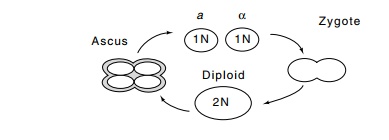Chapter: Genetics and Molecular Biology: Regulation of Mating Type in Yeast
Yeast Cell Cycle
The Yeast Cell Cycle
Yeast come in three cell-types, the haploid MATa and MATα mating types, and diploid MATa/α. Haploid cells of opposite cell types can conjugate to form a diploid a/α cell which is incapable of further mating. Under starvation conditions the a/α diploid, but not haploid cells, undergo meiosis to generate two a and two α mating-type spores in a structure called an ascus.

The status of the mating type of a clone or colony can easily be determined by mating with tester strains of known mating type (Fig. 16.1). Colonies to be checked should possess at least one nutritional requirement for growth. These colonies can be grown on rich plates containing all necessary nutrients and then replica plated onto lawns of tester cells of mating type MATa and of mating typeMATα that possess different nutritional requirements. After several hours of mating on rich medium, the plates are replicated onto minimal medium plates lacking the nutritional requirements of both the colonies to be checked and the tester strains. Combinations of parental cells that can mate will yield diploid conjugants capable of growing on the minimal medium through complementation of the defective alleles.
Figure 16.1 Scheme for the detection of colonies capable of mating withaandwith α mating type cells.

Most yeasts isolated from nature change their mating type nearly every generation. A culture of such yeast will therefore contain cells of a andαmating type that can conjugate to produce a/αdiploids whichgrow, but which do not mate further or change mating type. These switching cells are therefore called homothallic for their capability of mating with sister cells. To assay the current mating type status of such homothallic yeast, the behavior of individual cells must be examined. Fortunately this is straightforward since cells of opposite mating type expand towards one another in a characteristic shape called a shmoo which is easily recognized in the microscope.

Yeast that are to conjugate must induce and repress appropriate genes so as to synchronize their cell cycles, grow and adhere together, and finally fuse both cytoplasm and nucleus. Cells of one mating type sense the nearby presence of the opposite mating type by pheromone peptides of 12 and 13 amino acids long. Each cell-type secretes one pheromone and responds to the pheromone secreted by the opposite cell-type. The pheromone receptors span the membrane and are similar to rhodopsin and β-adrenergic receptors. On their cytoplasmic side the receptors interact with signaling proteins known as G proteins and through cascades of regulatory proteins, ultimately induce and repress the genes necessary for conjugation.
Related Topics